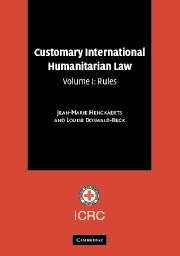Book contents
- Frontmatter
- Contents
- Foreword by ICRC President Jakob Kellenberger
- Foreword by Judge Abdul G. Koroma
- Foreword by Yves Sandoz
- Acknowledgements
- Introduction
- List of abbreviations
- Part I The Principle of Distinction
- Part II Specifically Protected Persons and Objects
- Part III Specific Methods of Warfare
- Part IV Weapons
- Chapter 20 General Principles on the Use of Weapons (Rules 70–71)
- Chapter 21 Poison (Rule 72)
- Chapter 22 Nuclear Weapons
- Chapter 23 Biological Weapons (Rule 73)
- Chapter 24 Chemical Weapons (Rules 74–76)
- Chapter 25 Expanding Bullets (Rule 77)
- Chapter 26 Exploding Bullets (Rule 78)
- Chapter 27 Weapons Primarily Injuring by Non-detectable Fragments (Rule 79)
- Chapter 28 Booby-traps (Rule 80)
- Chapter 29 Landmines (Rules 81–83)
- Chapter 30 Incendiary Weapons (Rules 84–85)
- Chapter 31 Blinding Laser Weapons (Rule 86)
- Part V Treatment of Civilians and Persons Hors De Combat
- Part VI Implementation
Chapter 29 - Landmines (Rules 81–83)
Published online by Cambridge University Press: 05 June 2012
- Frontmatter
- Contents
- Foreword by ICRC President Jakob Kellenberger
- Foreword by Judge Abdul G. Koroma
- Foreword by Yves Sandoz
- Acknowledgements
- Introduction
- List of abbreviations
- Part I The Principle of Distinction
- Part II Specifically Protected Persons and Objects
- Part III Specific Methods of Warfare
- Part IV Weapons
- Chapter 20 General Principles on the Use of Weapons (Rules 70–71)
- Chapter 21 Poison (Rule 72)
- Chapter 22 Nuclear Weapons
- Chapter 23 Biological Weapons (Rule 73)
- Chapter 24 Chemical Weapons (Rules 74–76)
- Chapter 25 Expanding Bullets (Rule 77)
- Chapter 26 Exploding Bullets (Rule 78)
- Chapter 27 Weapons Primarily Injuring by Non-detectable Fragments (Rule 79)
- Chapter 28 Booby-traps (Rule 80)
- Chapter 29 Landmines (Rules 81–83)
- Chapter 30 Incendiary Weapons (Rules 84–85)
- Chapter 31 Blinding Laser Weapons (Rule 86)
- Part V Treatment of Civilians and Persons Hors De Combat
- Part VI Implementation
Summary
Rule 81. When landmines are used, particular care must be taken to minimise their indiscriminate effects.
Practice
Volume II, Chapter 29, Section B.
Summary
State practice establishes this rule as a norm of customary international law applicable in both international and non-international armed conflicts. This rule applies to the use of anti-vehicle mines. It also applies in relation to anti-personnel landmines for States which have not yet adopted a total ban on their use.
International armed conflicts
Many of the rules in both the original and amended versions of Protocol II to the Convention on Certain Conventional Weapons, as well as other State practice, are aimed at obviating the indiscriminate effects of mines. The provisions of these treaties, which include the prohibitions of certain types of mines as well as further limitations, are specifically aimed at limiting the potentially indiscriminate damage caused by these weapons. Furthermore, practice shows that the customary rules applying to the conduct of hostilities, such as the principle of distinction (see Rules 1 and 7), the principle of proportionality (see Rule 14) and the obligation to take all feasible precautions in attack (see Rule 15), are equally applicable to the use of landmines.
The obligation to take particular care when using landmines is based on a number of rules that have been codified in Protocol II to the Convention on Certain Conventional Weapons. This Protocol sets out general rules on the emplacement of all landmines.
- Type
- Chapter
- Information
- Customary International Humanitarian Law , pp. 280 - 286Publisher: Cambridge University PressPrint publication year: 2005

